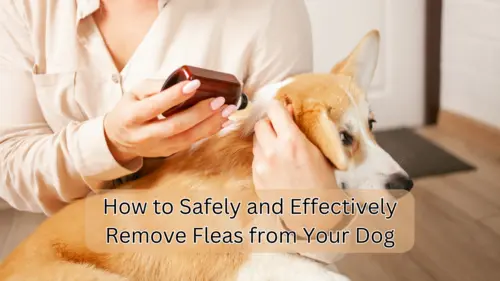
Admin / 8 -September -2023 – How to Safely and Effectively Remove Fleas from Your Dog
Dogs are very popular pets and are often considered family members. However, one of the challenges that pet owners often face is flea infestation.
Fighting fleas on dogs is a very important task to maintain the health and comfort of your pet. To help you with this problem, here is a step-by-step guide on how to get rid of fleas on your dog:
1. Identify the Fleas:
Know the characteristics of fleas on your dog. Fleas are parasites of the insect and arachnid class. Fleas commonly found on dogs can be categorized into 3 types, namely:
- Ticks
Adult ticks usually have a size of about 2-3 mm and are striking dark red in color. Female ticks that have been sucking blood can grow to over 1 cm, making them even more conspicuous. Not only do ticks make the skin itchy and irritated from their bites, they can also be carriers of dangerous diseases caused by bacteria and parasites in the blood.
- Flea
Adult fleas are usually around 2-4 mm in size and are an elegant brown color. They have the ability to jump quickly up to 200 times their body length, so they are not easily spotted. Bites from fleas can cause itchy and reddened skin in dogs. In dogs with high skin sensitivity, the bites can trigger a skin disorder called flea allergy dermatitis, which if left untreated can lead to additional bacterial infections of the dog’s skin. In addition, keep in mind that they also act as vectors for the spread of tapeworms, which is something to be aware of.
- Mites
Mites are very small, about 0.2-0.4 mm, which makes them almost invisible to the naked eye. Some types of mites live underneath the dog’s skin layer, making holes in the skin to live and take in nutrients. This process can then cause the dog’s skin to feel dry, crusty and itchy. When left untreated, this condition can also potentially lead to additional bacterial infections of the dog’s skin. So, it is important to address this issue immediately.
2. Isolate the Dog:
If you find fleas on your dog, isolate the pet from other animals to prevent the spread of fleas.
3. Bathe the Dog with Ant-flea Shampoo:
Use an anti-flea shampoo recommended by your veterinarian. Bathe your dog with this shampoo as directed on the label. Make sure the shampoo is evenly distributed throughout the dog’s body, and leave it on for a few minutes before rinsing.
4. Comb with Fine-Tooth Flea Comb:
After bathing, use a fine-tooth flea comb to comb through the dog’s coat. Make sure you do this in a well-lit area or with enough light so that you can see the detached flea. This comb helps remove fleas and their eggs.
5.Use Topical Flea Medication:
Consult your veterinarian about the proper use of topical flea medication. Usually, this medication is applied to the skin on the dog’s back and can provide protection for several weeks.
6. Give Oral Flea Medicine:
The vet may also prescribe oral flea medication that should be administered according to the recommended dosage. This kills the fleas when they suck the dog’s blood.
7. Wash the Dog’s Nest and Equipment:
Wash all bedding, blankets, and dog supplies in hot water, then dry them with heat to kill any fleas and eggs that may be there.
8. Environmental Treatments:
Fleas not only live on dogs, but also in their environment. Vacuum your home carefully, especially in areas where dogs frequent. Safely dispose of vacuum bags after use. Also, consider using flea control products for your environment.
9. Routine Examinations:
Perform regular check-ups on your dog to ensure that no fleas have returned. This is important to prevent re-infestation.
10. Consult a Veterinarian:
If the flea infestation is persistent or if your dog is having a serious allergic reaction to flea bites, consult your veterinarian immediately for further treatment and proper recommendations.
It is important to remember that getting rid of fleas in dogs can take time, and you may need to run regular preventive measures. Consult your vet for advice that suits your dog’s specific needs.
